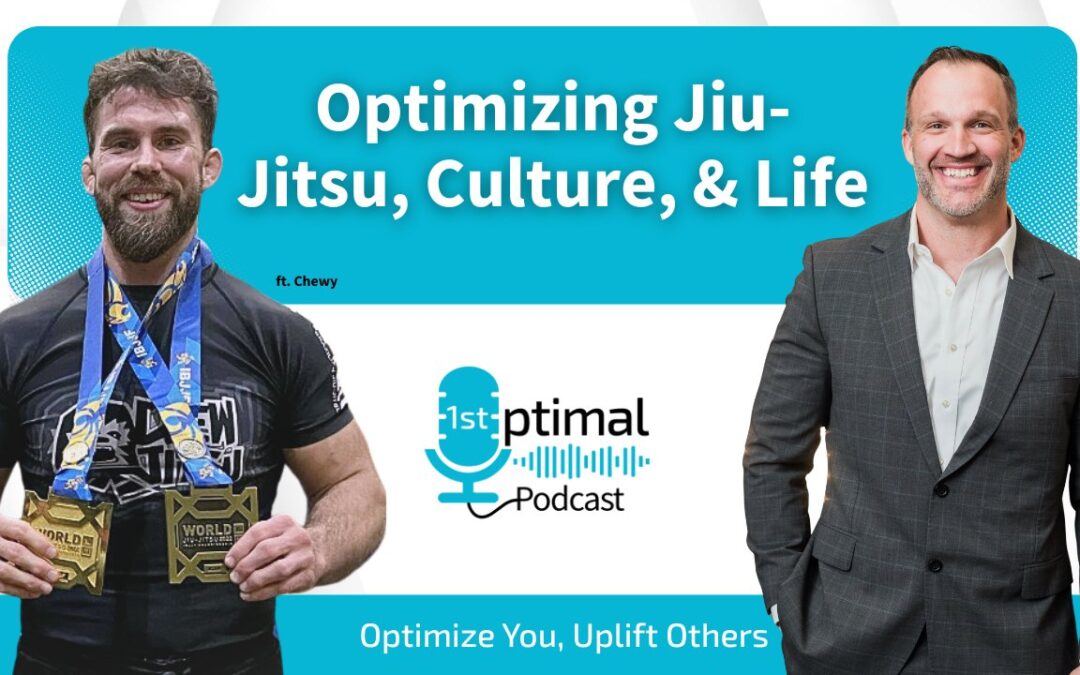There’s a unique clarity that comes from confronting physical discomfort in a controlled setting. As our latest podcast guest explains, after you’ve spent weeks getting smashed on the mats, everyday stressors seem much more manageable. We sat down with Nick Albin, the world-renowned coach from Chewy BJJ, to discuss how the challenges of Jiu-Jitsu build a profound mental toughness that transfers to every other area of life. This conversation is about more than just grappling; it’s about learning to tolerate pressure, overcome fear, and develop the unshakable accountability that comes from a practice where you simply can’t fake it.
From the Mat to Mindset: What BJJ Can Teach You About Grit, Growth & Greatness
Brazilian Jiu-Jitsu (BJJ) is more than just a combat sport—it’s a crucible for mental toughness, personal discipline, and self-discovery. In this episode of the 1st Optimal Podcast, we sit down with a world-class grappler and coach who shares how his journey from wrestling in high school to building a successful BJJ gym and launching an innovative tournament series, the Chewjitsu Open, offers lessons that extend far beyond the mat.
Whether you’re a seasoned athlete, weekend warrior, or high-achieving professional looking for an edge, this episode delivers powerful takeaways on resilience, training, and building culture from the ground up.
The Power of Passion: Let Your Calling Find You
One of the most striking themes in this episode is that not all success is carefully planned. Sometimes, it unfolds naturally when you follow what energizes you.
The guest didn’t initially set out to become a top BJJ coach or run a thriving gym. Instead, he followed a deep-seated passion for grappling that began in high school wrestling. What started as a search for an MMA gym after graduation evolved into a life centered around Jiu-Jitsu.
“I didn’t choose Jiu-Jitsu. It kind of chose me,” he says.
This speaks to a broader truth: when you’re aligned with your purpose, motivation becomes automatic. You don’t need grand plans or flashy goals—just the discipline to keep showing up.
Meet Nick “Chewy” Albin: The Man Behind Chewjitsu
Our guest is Nick “Chewy” Albin, a BJJ Black Belt, active competitor, and the founder of Chewjitsu. Operating out of Derby City MMA in Louisville, Kentucky, he’s become a respected voice in the martial arts community for his technical skill and his approach to teaching and life. His journey demonstrates the profound impact of consistency and dedication. Chewy embodies the principles of grit and discipline that are essential for anyone striving for high performance, whether on the mats or in the boardroom. His story shows how committing to a process of continuous improvement builds a foundation for meaningful personal and professional growth.
The Chewjitsu Podcast: Insights on Training, Health, and Mindset
Beyond the gym, Chewy shares his knowledge on The Chewjitsu Podcast, co-hosted with Dr. Eugene Tsozik. The show moves past grappling techniques to examine the pillars of a successful athletic life: mindset, resilience, overall health, and injury prevention. These discussions offer a blueprint for developing a strong mental framework to handle pressure and overcome challenges—skills directly applicable to demanding careers. It’s a valuable resource for anyone interested in the connection between physical performance and mental fortitude, providing actionable insights that extend far beyond the world of martial arts.
Culture Starts with Leadership
Whether it’s in business or sports, culture isn’t something you write on a wall—it’s something you live.
The coach emphasizes that gym culture stems from how leaders carry themselves. If a leader trains with integrity, communicates openly, and prioritizes safety and growth, that energy naturally trickles down.
Key Elements of a Strong Gym Culture
- Lead by Example: Embody the values you expect from others.
- Prioritize Safety: Good training partners look out for each other.
- Remove Toxic Influences: One bad attitude can poison the entire room.
- Stay Open to Questions: Encourage curiosity and collaboration.
“If you’re not willing to live the culture yourself, you can’t expect others to buy in,” he explains.
This principle applies equally in business. Your team will model your behavior—good or bad.
Lessons from the Chewjitsu Open: Rethinking Competition
Tired of BJJ tournaments where athletes get only one or two matches, the guest created the Chewjitsu Open, a unique submission-only format with a 70–75% finish rate.
His goal? Strip away the stress of points and brackets, and allow competitors to just “go.” The result has been a competition format that pushes athletes to focus on performance, not perfection.
“I wanted people to experience the joy of just competing. Turn off your brain and go test yourself.”
This model of high-rep exposure and low-pressure mindset training could revolutionize not only how we think about martial arts competitions but also how we develop skill mastery in any domain.
A Unique Competition Format: Round-Robin, Madison Style
What truly sets the Chewjitsu Open apart is its structure, designed to maximize mat time and minimize stress. It’s a submission-only tournament, which means the path to victory is by finishing the fight, not by scoring points. This encourages a more active and authentic style of grappling. The tournament uses a “Round-Robin, Madison style” bracket, which is a game-changer. Instead of a traditional single-elimination format where one loss sends you home, competitors are grouped with others of similar weight, age, and experience. You get to compete against everyone in your group, guaranteeing multiple matches and a full day of valuable experience.
Prizes, Perks, and Post-Tournament Training
While the experience is the main draw, there are plenty of incentives for top performers. Winners can earn medals, custom championship belts, and team banners. For adults who enter the optional “Absolute” divisions, there are even cash prizes on the line. But perhaps the most valuable perk is the opportunity for continued growth after the matches are over. Competitors can attend a three-hour No Gi seminar taught by the founder, Nick “Chewy” Albin. This transforms the event from a simple tournament into a comprehensive training experience, allowing you to immediately apply new insights from a world-class instructor.
Safety and Fun for Youth Competitors
The Chewjitsu Open is designed for all ages, with a thoughtful approach to its youngest athletes. Recognizing that the goal for kids should be learning and enjoyment, the rules are adapted to ensure a safe environment. For youth divisions (ages 8 and under at the beginner/white belt level), the matches are points-only instead of submission-only. This simple adjustment removes the pressure of submissions and reduces the risk of injury, allowing kids to build confidence and a love for the sport. It’s a forward-thinking model that prioritizes long-term development over short-term wins, creating a positive introduction to competitive Jiu-Jitsu.
Upcoming 2025 Chewjitsu Open Locations
If you’re ready to test your skills in this unique format, the Chewjitsu Open is expanding to several locations, making it easier than ever to participate. These events are often held in family-friendly destinations, turning a competition weekend into a potential short vacation. For any high-performer, having a concrete goal on the calendar is a powerful tool for focus and discipline. It gives your training a clear purpose and helps you stay consistent, even when your schedule is demanding. You can find a full list of upcoming events and register on their official site. Here are the dates to mark on your calendar for 2025:
- Myrtle Beach, SC: May 31–June 1
- Cedar Point, OH: July 5–6
- Branson, MO: August 2–3
- Frankenmuth, MI: November 8–9
- Gatlinburg, TN: December 6–7
Training Smart: Fuel, Recovery, and Focus
You can’t build a high-performance engine on junk fuel—or with poor recovery.
This episode takes a practical dive into the nuts and bolts of smart training, especially how to cut weight or build strength without wrecking your health.
How Often Should You Train? Matching Frequency to Your Goals
One of the most common questions in BJJ is, “How often should I be on the mat?” The answer depends entirely on your goals, lifestyle, and capacity for recovery. For beginners, training twice a week is a fantastic start to learn fundamental moves and build a solid base. If you want to accelerate your progress or start thinking about competition, increasing that to three or four sessions a week will help you retain techniques and get more live rolling experience. For serious competitors, training can be a daily practice of five or six days a week to sharpen their edge.
Ultimately, consistency trumps intensity. For busy professionals, the “best” frequency is the one you can stick with long-term without sacrificing your health, career, or family. Pushing for five days a week when your sleep is poor and stress is high is a recipe for burnout, not progress. True optimization comes from finding a sustainable rhythm that allows for adequate recovery. When you understand your body’s unique data—from hormone levels to stress markers—you can tailor your training load to your actual capacity, ensuring every hour on the mat moves you forward.
Tips for Smarter Training and Weight Management
- Work With a Nutrition Coach: Not just to lose weight, but to feel fueled and functional.
- Avoid Crash Cuts: Old-school “eat less, train more” doesn’t support sustainable performance.
- Track Macronutrients: Nutrient-dense foods support better energy and recovery.
- Sleep and Stress Matter: Ignoring recovery can lead to illness or injury.
“When I worked with a nutritionist, it was the easiest weight cut I ever had. I felt amazing in training.”
It’s a reminder that elite performance doesn’t come from pushing harder—it comes from recovering smarter and fueling right.
Training Isn’t Winning: How to Be a Great Training Partner
Whether you’re brand new to Jiu-Jitsu or managing a high-level athlete, gym culture thrives when people train with care—not just intensity.
“Winning in training doesn’t count. If you want to win, go compete.”
Golden Rules for Good Training Etiquette
- Focus on Development – Training is for learning, not domination.
- Take Care of Your Partners – No one wants to roll with someone reckless.
- Stay Humble – The mats don’t care how strong or smart you are off them.
- Be Consistent – Skill comes from reps, not random intensity.
Understanding Gym Traditions: The Bow of Respect
One of the first traditions you’ll notice in a BJJ gym is the bow. It might seem like a simple formality, but it’s a cornerstone of the gym’s culture. When you bow before stepping on or off the mats, or to your training partner before a roll, you’re doing more than just going through the motions. It’s a gesture of mutual respect—an acknowledgment that, as one source puts it, flows from the heart with honesty. This tradition symbolizes the warrior spirit, where honor for your opponent is just as important as the techniques you learn. It sets the tone for a focused, collaborative training session where everyone is there to help each other improve.
This practice has deep roots in martial arts, stemming from Asian cultures where bowing is a fundamental way to show gratitude and honor. It’s a sign of respect for the lineage of the art, for your instructors who guide you, and for the shared space where you all train. By taking a moment to bow, you’re participating in a tradition that reinforces humility and mindfulness. It’s a small act that reminds you to leave your ego at the door and approach your training with an open mind, ready to learn from everyone in the room, regardless of their belt color.
The Transfer of Grit: Why BJJ Builds Mental Toughness for Life
Beyond techniques and tournament medals, BJJ offers a rare opportunity to confront discomfort in a controlled setting. Being crushed by a 300-pound opponent teaches something a Zoom meeting never could.
“After six weeks of getting my face smashed in during fight camp, writing emails doesn’t feel so hard.”
Key Mental Takeaways from BJJ Training
- Tolerate Discomfort: Learn to stay calm under pressure—literally.
- Overcome Fear: Exposure to difficult situations builds resilience.
- Delay Gratification: You can’t shortcut progress on the mat or in life.
- Accountability: You can’t fake your way through Jiu-Jitsu. It’s all earned.
This mental toughness often becomes the foundation for success in business, relationships, and parenting.
Productivity Hacks for the High Performer
Running a gym, creating content, building a competition series, training, and raising a family isn’t easy. But it’s possible with a few intentional habits:
Productivity Strategies from the Mat
- Batch Your Time: Separate blocks for training, work, and family.
- Be Flexible with Rigid Anchors: Have daily non-negotiables (like family breakfast), but stay adaptable.
- Do What Energizes You: Tasks become easier when you actually enjoy them.
- Get Reps: Mastery comes from doing, not overthinking.
“What used to take me hours now takes me 15 minutes. Reps make everything more efficient.”
Applying the 80/20 Rule to Your BJJ Game
This idea of getting more efficient with reps leads directly to another powerful concept: the 80/20 Rule. Also known as the Pareto Principle, it suggests that 80% of your results come from just 20% of your efforts. In Jiu-Jitsu, this means a small handful of your go-to techniques are likely responsible for the vast majority of your successful submissions, sweeps, and passes. Instead of trying to master every move you see on Instagram, the key is to identify your personal 20%—that A-game you can rely on under pressure.
Once you identify your top two or three most effective techniques, the strategy is simple: dedicate the majority of your training time to making them unstoppable. This means drilling them relentlessly, refining the entries from various positions, and understanding the common counters so you can stay one step ahead. This isn’t about having a limited game; it’s about strategically investing your energy where it delivers the highest return. This data-driven approach to training mirrors how high-performers optimize every other area of their lives, from business decisions to their personal health protocols.
Let Your Life Speak Through Jiu-Jitsu
The most impactful takeaway from this podcast isn’t just about BJJ—it’s about life alignment. You don’t need to have all the answers to get started. Just find something worth suffering for and follow the trail.
Whether you’re a grappler, coach, entrepreneur, or parent, the lesson is clear:
- Pursue what lights you up.
- Lead by example.
- Push through the hard days.
- Keep showing up.
🎙 Enjoyed this conversation with Jiu-Jitsu expert Turd Ferguson?
At 1st Optimal, we provide comprehensive blood testing, performance-driven health plans, and personalized recovery support to help you optimize your health and uplift others around you.
👉 Ready to take control of your energy, strength, and recovery?
📅 Book Your Free Discovery Call: 1stOptimal.com
📞 Call Us: (816) 744-6814
📧 Email: membersupport@1stoptimal.com
🔗 Listen to the full episode on your favorite platform:
🎧 Spotify | Apple Podcasts | Amazon Music | Google Podcasts
📺 Watch it on YouTube: YouTube.com/@1stOptimal
Optimize You. Uplift Others
Frequently Asked Questions
I’m a busy professional. How can I realistically fit BJJ training into my schedule without it taking over my life? This is a common concern, and the key is to focus on consistency rather than frequency. As Nick’s journey shows, the benefits come from showing up over time, not from burning yourself out. Start with a manageable goal, like two classes a week. A good gym will understand the demands of a career and family. The goal is to find a sustainable rhythm that adds to your life, not one that creates more stress. You’ll find that the mental clarity you gain from training often makes you more efficient and focused in your work, making the time investment well worth it.
The idea of getting ‘smashed on the mats’ sounds intense. Is BJJ a safe activity for someone in their 30s or 40s who can’t afford an injury? It’s a valid question. While BJJ is a physical contact sport, a good gym prioritizes safety and smart training above all else. The culture of the gym, as the post highlights, is critical. Look for a place where the instructors and senior students emphasize control and mutual respect over “winning” in training. Your primary responsibility is to listen to your body and communicate with your training partners. Tapping early and often is a sign of intelligence, not weakness. It’s about learning your limits and training in a way that ensures you can come back the next day.
How does learning to handle physical pressure in BJJ actually translate into better performance at work? Think of it as practical stress inoculation. When you’re in a difficult position in Jiu-Jitsu, you have to learn to stay calm, breathe, and think your way out of the problem while under intense physical pressure. After you’ve practiced that skill repeatedly, a looming project deadline or a difficult conversation with a client feels significantly less daunting. You build a genuine resilience and an ability to tolerate discomfort, which allows you to operate with more composure and clarity in high-stakes professional situations.
I’m more interested in the health and mental benefits than competing. Will I still fit into a typical BJJ gym culture? Absolutely. While competitors often get the spotlight, the vast majority of people who train Jiu-Jitsu do it for personal development, fitness, and community. The Chewjitsu Open was created specifically because traditional competition can be stressful. A healthy gym culture supports everyone’s goals, whether that’s winning a world title or simply having a productive outlet after a long day at the office. The core of the practice is about shared growth, and you’ll find that your training partners are your greatest resource for improvement, not your adversaries.
The post mentions the 80/20 rule. How can I apply that to get the most out of my training if I only have a few hours a week? This is the perfect mindset for a busy person. Instead of trying to learn every technique you see, focus on mastering a few fundamental moves that work for you. Identify one or two high-percentage submissions, a reliable guard pass, and a solid escape. By dedicating your limited time to drilling and refining this core “A-game,” you’ll build true competence much faster than if you spread your efforts too thin. It’s about strategically investing your energy where it will yield the greatest results, ensuring every hour on the mat is a step forward.






